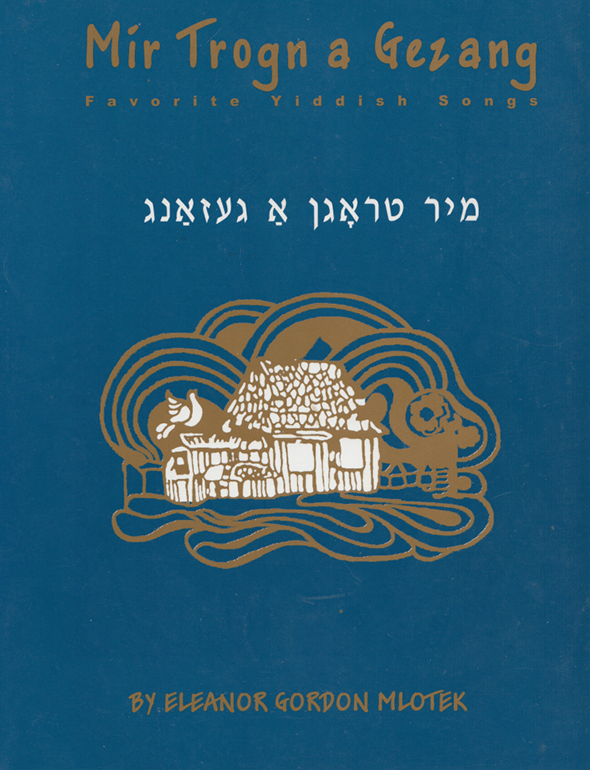Text by Itsik Manger (see note to Eynzam, on page 162), music by Hertz Rubin (1911 – 1958). This version of the melody was commonly sung by second-generation American Jews. In this version the last stanza honors Rabeynu Tam whereas the original reads that the song was written to spite him.
In the last stanza of this humorous song, Manger imitates the closing formula of the old folk poets and Purim shpiler of the 16th century: “Der unz das lidlayn hat gemakht, khosn un kale hat ers tsu eren gemakht,” or “Der unz das lidlayn hat gemakht, er hat es gemakht bay eyner nakht.” (A poet wrote this song one night, in honor of bride and groom).

Let us sing the beautiful song
Haydl, didl, dam –
about how the golden peacock flies
over the Black Sea
carrying a love note,
a beautiful love note,
for our Rabbi Tam.
Who wrote the note?
Haydl, didl, day –
The note was written by
the Queen of Turkey.
Wrote it with red ink
and sealed it up fast
with three hot tears.
What is written in the note?
Haydl, didl, du –
“Rabeynu Tam, I love you,
Why are you silent? Nu?
I’m not eating, I’m not drinking,
I am becoming broken by longing.
I have no peace.”
So what does Rabenyu Tam do?
Haydl, didl, de –
he strokes his peyes and beard
and goes, “Feh!” three times.
And the little goat in the stable
the little white kid
joins in with a “Meh!”
Well, and the Rebetsin?
Haydl didl doy –
She smacks him with the rolling pin
and says to him, thus:
“You have Shikses on your mind.
Well, and me, what about me?
Your devoted wife!”
Guess who wrote this song?
Haydl, didl, dam –
A tailor’s apprentice did it,
in honor of Rabeynu Tam.
And on Shabes, between day and night
some joker put in his own lines
perfectly according to the rhyme.
Lomir zingen dos sheyne lid
Haydl, didl, dam —
Vi di goldene pave flit
lbern shvartsn yam.
Un trogt a libes-brivele,
A sheyne libes-brivele,
Far dem Rabeynu Tam.
Ver hot geshribn dos brivele?
Haydl, didl, day —
Geshribn hot dos brivele
Di malke fun terkay.
Geshribn es mit roytn tint
Un farkhasmet es geshvind
Mit heyse trern dray.
Vos shteyt geshribn in brivele?
Haydl, didl, du —
“Rabeynu Tam ikh libe dikh,
Vos zhe shvaygstu, nu?
lkh ese nish’, ikh trinke nish’,
lkh ver tsezetst fun benkenish,
lkh habe nisht keyn ru,”
Vos zhe tut Rabeynu Tam?
Haydl, didl, de —
Er glet di peyes un di bord
Un makht dray mol “fe”.
Un dos tsigele in shtal,
Un dos vayse tsigele
Helft im unter, “me”.
Nu un zi, di rebetsin?
Haydl, didl, doy —
Zi klapt im mitn valgerholts
Un zogt tsu im azoy:
-Shikses lign dir in zin,
Nu un yakh, un yakh vu bin?
Dayn heys-gelibte froy!
Treft ver s’hot dos lid gemakht?
Haydl, didl, dam —
A shnayder-yung hot es gemakht
Lekoved dem Rabeynu Tam.
Un shabes tsvishn tog un nakht
Hot a lets arayngelakht
Akurat tsum gram.
לאָמיר זינגען דאָס שײנע ליד
הײַדל, דידל, דאַם —
װי די גאָלדענע פּאַװע פֿליט
איבערן שװאַרצן ים.
און טראָגט א ליבעס–בריװעלע,
אַ שײנע ליבעס-בריװעלע,
פֿאַר דעם רבינו תֹּם.
װער האָט געשריבן דאָס בריװעלע?
הײַדל, דידל, דײַ —
געשריבן האָט דאָס בריװעלע
די מלכּה פֿון טערקײַ.
געשריבן עס מיט רױטן טינט
און פֿאַרחתמעט עס געשװינד
מיט הײסע טרערן דרײַ.
װאָס שטײט געשריבן אין בריװעלע?
הײַדל, דידל, דו —
“רבינו תם איך ליבע דיך,
װאָס זשע שװײַגסטו, נו?
איך עסע ניש’, איך טרינקע ניש’,
איך װוער צעזעצט פֿון בענקעניש,
איך האַבע נישט קײן רו”.
װאָס זשע טוט רבינו תּם?
הײַדל, דידל דע —
ער גלעט די פּאה און די באָרד
און מאַכט דרײַ מאָל “פע”.
און דאָס ציגעלע אין שטאַל,
און דאָס װײַסע ציגעלע
העלפֿט אים אונטער “מע”.
נו, און זי, די רביצין?
הײַדל, דידל, דױ —
זי קלאַפּט אים מיטן װאַלגערהאָלץ
און זאָגט צו אים אַזױ:
— שיקסעס ליגן דיר אין זין,
נו און יאַך און יאַך װוּ בין?
דײַן הײס-געליבטע פֿרױי!
טרעפֿט װער ס’האָט דאָס ליד געמאַכט?
הײַדל, דידל, דאַם —
אַ שנײַדעריונג האָט עס געמאַכט
לכּבֿוד דעם רבינו תּם.
און שבת צװישן טאָג און נאַכט
האָט אַ לץ אַרײַנגעלאַכט
אַקוראַט צום גראַם.
Song Title: Rabeynu Tam

First published in 1972, Mir Trogn A Gezang: Favorite Yiddish Songs was reprinted six more times (in 1977, 1982, 1985, 1987, 1988, 2000) due to popular demand. The songs in this anthology represent a sampling of beloved folk and well-known Yiddish songs, many of which are scattered in various song collections; some appear in very rare and inaccessible collections; and some were never before published. Folk songs comprise about a third of this volume and were selected mainly on the basis of popularity and sometimes for their historic significance. Needless to say, they are only representative of the vast, rich treasure of Yiddish folk material. The selection was made not only on the basis of personal preference, but in the knowledge they are favorites of many who sing these songs. Most of the songs represent the repertoire that was sung at Yiddish summer camps, May 1st demonstrations and at social gatherings. Many songs were introduced to American Jewry by Jewish immigrants who came to the United States after World War II, for whom these songs had been favorites in Poland and other East European communities destroyed by the Nazis.